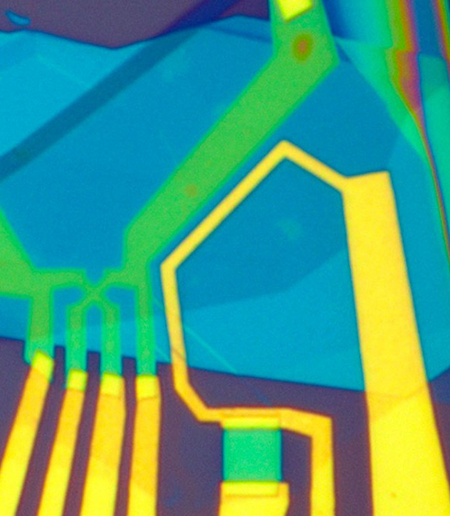Aug 21 2020
When magnetic fields are measured, having a range is helpful—quite similar to opera singers and actors.
 Researchers led by Katja Nowack, assistant professor of physics, created this micron-scale Hall-effect sensor by sandwiching graphene between sheets of hexagonal boron nitride. Image Credit: Cornell University.
Researchers led by Katja Nowack, assistant professor of physics, created this micron-scale Hall-effect sensor by sandwiching graphene between sheets of hexagonal boron nitride. Image Credit: Cornell University.
Using an ultrathin graphene “sandwich,” Cornell University scientists have now developed a small magnetic field sensor that can work across a higher range of temperatures when compared to earlier sensors. At the same time, it can also detect minute changes in the magnetic fields that otherwise might disappear inside a larger magnetic background.
The researchers’ article titled “Magnetic Field Detection Limits for Ultraclean Graphene Hall Sensors” was published in the Nature Communications journal on August 20th, 2020.
The research group was headed by Katja Nowack, the study’s senior author and assistant professor of physics in the College of Arts and Sciences at Cornell University.
Nowack’s laboratory focuses on applying scanning probes to perform magnetic imaging. The superconducting quantum interference device, or SQUID for short, is the most preferred probe in the laboratory. This probe works suitably even in small magnetic fields and at low temperatures.
We wanted to expand the range of parameters that we can explore by using this other type of sensor, which is the Hall-effect sensor. It can work at any temperature, and we’ve shown it can work up to high magnetic fields as well. Hall sensors have been used at high magnetic fields before, but they’re usually not able to detect small magnetic field changes on top of that magnetic field.
Brian Schaefer, Study Lead Author and Doctoral Student, Cornell University
The Hall effect is a popular phenomenon in the field of condensed matter physics. A current flowing through a sample is bent by a magnetic field. This produces a voltage across the two sides of the sample that is in proportion to this magnetic field.
In this context, Hall-effect sensors are employed in many different technologies, ranging from anti-lock brakes to robotics and cellular phones. Such sensors are often designed from traditional semiconductors, similar to gallium arsenide and silicon arsenide.
Nowack’s research team decided to adopt a more innovative technique.
Graphene sheets have been increasingly used in the last 10 years. They are single layers of carbon atoms, assembled in a honeycomb lattice.
However, graphene devices usually do not match up to those produced from other kinds of semiconductors, especially when the graphene sheet is directly positioned on a silicon substrate; this is because the graphene sheet often “crumples” on the nanoscale, inhibiting its electrical characteristics.
Nowack’s research team has now implemented a newly developed method to unlock the full potential of graphene—closely packing it between hexagonal boron nitride sheets. Hexagonal boron nitride and graphene have the same crystal structure but the former is an electrical insulator, which enables the graphene sheet to remain flat.
Within the sandwich structure, graphite layers serve as electrostatic gates to adjust the proportion of electrons that can pass electricity in the graphene.
Lei Wang, the study’s co-author and a former postdoctoral researcher from the Kavli Institute at Cornell for Nanoscale Science, had pioneered the sandwich method.
He also worked in the laboratory of the study’s co-senior author Paul McEuen, the John A. Newman Professor of Physical Science and co-chair of the Nanoscale Science and Microsystems Engineering (NEXT Nano) Task Force, which is part of the provost’s Radical Collaboration initiative.
The encapsulation with hexagonal boron nitride and graphite makes the electronic system ultraclean. That allows us to work at even lower electron densities than we could before, and that’s favorable for boosting the Hall-effect signal we are interested in.
Katja Nowack, Study Senior Author and Assistant Professor of Physics, College of Arts and Sciences, Cornell University
The team was able to develop a micrometer-scale Hall sensor that works equally well as the most optimal Hall sensors reported at room temperatures. This sensor also operates at temperatures down to 4.2 K (or −452.11 °F), outpacing other Hall sensors.
In addition, the graphene sensors are so accurate that they can detect even minute changes in a magnetic field against a background field that is million times its size or bigger by six orders of magnitude.
Even high-quality sensors find it difficult to detect such small changes, because the voltage response in a high magnetic field becomes nonlinear and hence harder to analyze.
Nowack has planned to integrate the graphene Hall sensor into a scanning probe microscope for imaging quantum materials and also for investigating physical phenomena, like how non-traditional superconductivity is destroyed by magnetic fields and the ways current passes through unique groups of materials, like topological metals.
“Magnetic field sensors and Hall sensors are important parts of many real-world applications. This work puts ultraclean graphene really on the map for being a superior material to build Hall probes out of. It wouldn’t be really practical for some applications because it’s hard to make these devices,” added Nowack.
“But there are different pathways for materials growth and automated assembly of the sandwich that people are exploring. Once you have the graphene sandwich, you can put it anywhere and integrate it with existing technology,” concluded Nowack.
The study’s co-authors include Alexander Jarjour, a doctoral student, and also scientists from the National Institute for Materials Science based in Tsukuba, Japan.
The study was funded by the National Science Foundation and the Cornell Center for Materials Research—an NSF Materials Research Science and Engineering Center.
The team used the Columbia Nano Initiative Clean Room and the Cornell NanoScale Science and Technology Facility for their study.
Journal Reference
Schaefer, B. T., et al. (2020) Magnetic Field Detection Limits for Ultraclean Graphene Hall Sensors. Nature Communications. doi.org/10.1038/s41467-020-18007-5.